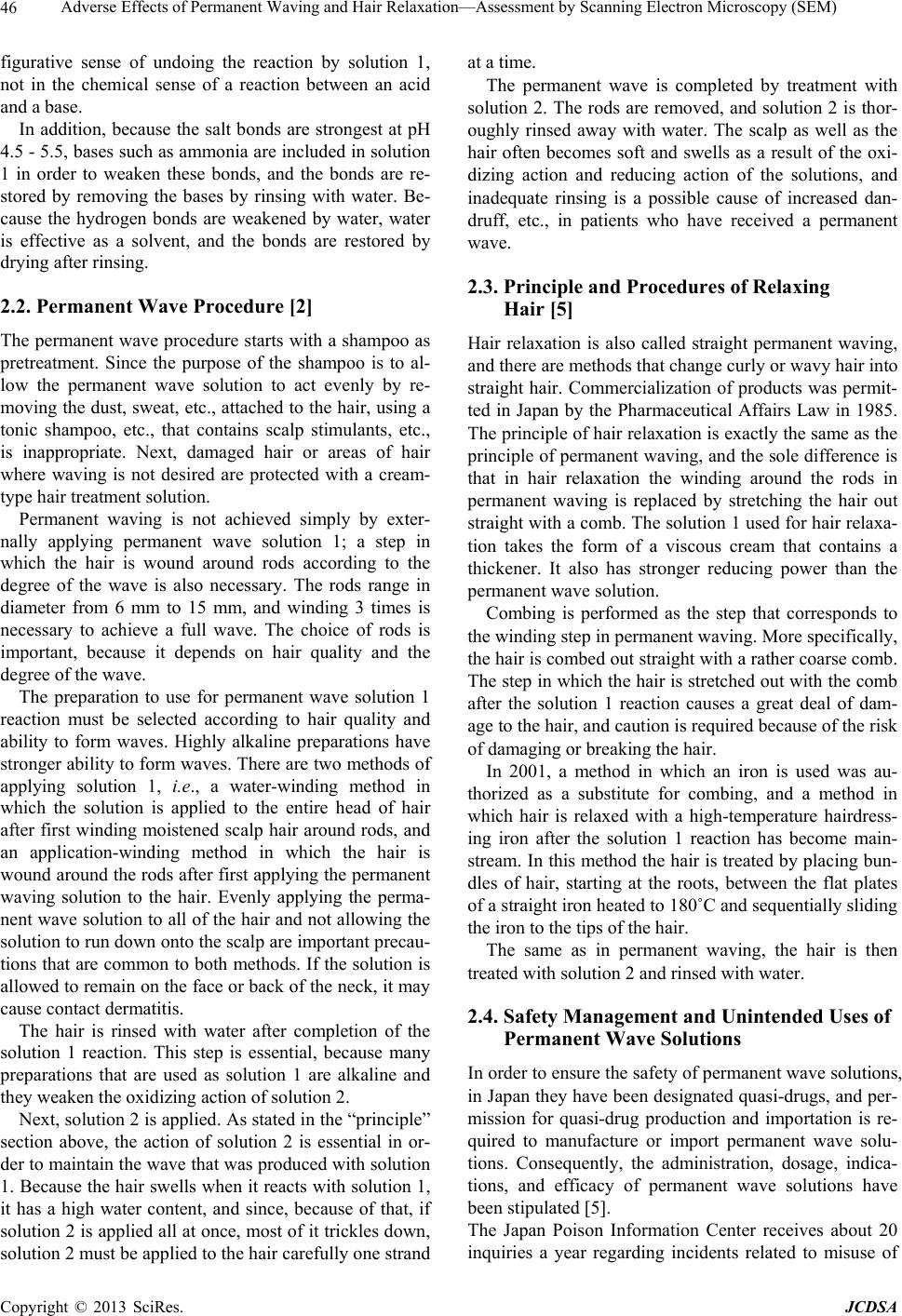
Adverse Effects of Permanent Waving and Hair Relaxation—Assessment by Scanning Electron Microscopy (SEM)
46
figurative sense of undoing the reaction by solution 1,
not in the chemical sense of a reaction between an acid
and a base.
In addition, because the salt bonds are strongest at pH
4.5 - 5.5, bases such as ammonia are included in solution
1 in order to weaken these bonds, and the bonds are re-
stored by removing the bases by rinsing with water. Be-
cause the hydrogen bonds are weakened by water, water
is effective as a solvent, and the bonds are restored by
drying after rinsing.
2.2. Permanent Wave Procedure [2]
The permanent wave procedure starts with a shampoo as
pretreatment. Since the purpose of the shampoo is to al-
low the permanent wave solution to act evenly by re-
moving the dust, sweat, etc., attached to the hair, using a
tonic shampoo, etc., that contains scalp stimulants, etc.,
is inappropriate. Next, damaged hair or areas of hair
where waving is not desired are protected with a cream-
type hair treatment solution.
Permanent waving is not achieved simply by exter-
nally applying permanent wave solution 1; a step in
which the hair is wound around rods according to the
degree of the wave is also necessary. The rods range in
diameter from 6 mm to 15 mm, and winding 3 times is
necessary to achieve a full wave. The choice of rods is
important, because it depends on hair quality and the
degree of the w av e.
The preparation to use for permanent wave solution 1
reaction must be selected according to hair quality and
ability to form waves. Highly alkaline preparations have
stronger ability to form waves. There are two methods of
applying solution 1, i.e., a water-winding method in
which the solution is applied to the entire head of hair
after first winding moistened scalp hair around rods, and
an application-winding method in which the hair is
wound around the rods after first applying the permanent
waving solution to the hair. Evenly applying the perma-
nent wave solution to all of the hair and not allowing the
solution to run down onto the scalp are important precau-
tions that are common to both methods. If the solution is
allowed to remain on the face or ba ck of the neck, it may
cause contact dermatitis.
The hair is rinsed with water after completion of the
solution 1 reaction. This step is essential, because many
preparations that are used as solution 1 are alkaline and
they weaken the oxidizing action of solution 2.
Next, solution 2 is applied . As stated in the “principle”
section above, the action of solution 2 is essential in or-
der to maintain the wave th at was produced with solution
1. Because the hair swells when it reacts with solution 1,
it has a high water content, and since, because of that, if
solution 2 is applied all at once, most of it trickles down,
solution 2 must be applied to the hair carefully one strand
at a time.
The permanent wave is completed by treatment with
solution 2. The rods are removed, and solution 2 is thor-
oughly rinsed away with water. The scalp as well as the
hair often becomes soft and swells as a result of the oxi-
dizing action and reducing action of the solutions, and
inadequate rinsing is a possible cause of increased dan-
druff, etc., in patients who have received a permanent
wave.
2.3. Principle and Procedures of Relaxing
Hair [5]
Hair relaxation is also called straight permanent waving,
and there are methods that change curly or wavy hair into
straight hair. Commercialization of products was permit-
ted in Japan by the Pharmaceutical Affairs Law in 1985.
The principle of hair relaxation is exactly the same as the
principle of permanent waving, and the sole difference is
that in hair relaxation the winding around the rods in
permanent waving is replaced by stretching the hair out
straight with a comb. The solution 1 used for hair relaxa-
tion takes the form of a viscous cream that contains a
thickener. It also has stronger reducing power than the
permanent wave solution.
Combing is performed as the step that corresponds to
the winding step in permanent waving. More specifically,
the hair is combed out straight with a rather coarse comb.
The step in which the hair is stretched out with th e comb
after the solution 1 reaction causes a great deal of dam-
age to the hair, and caution is required because of the risk
of damaging or breaking the hair.
In 2001, a method in which an iron is used was au-
thorized as a substitute for combing, and a method in
which hair is relaxed with a high-temperature hairdress-
ing iron after the solution 1 reaction has become main-
stream. In this method the hair is treated by placing bun-
dles of hair, starting at the roots, between the flat plates
of a straight iron heated to 180˚C and sequentially sliding
the iron to the tips of the hair.
The same as in permanent waving, the hair is then
treated with solution 2 and rinsed with water.
2.4. Safety Management and Unintended Uses of
Permanent Wave Solutions
In order to ensure the safety of permanent wave solutions,
in Japan they have been designated quasi-drugs, and per-
mission for quasi-drug production and importation is re-
quired to manufacture or import permanent wave solu-
tions. Consequently, the administration, dosage, indica-
tions, and efficacy of permanent wave solutions have
been stipulated [5].
The Japan Poison Information Center receives about 20
inquiries a year regarding incidents related to misuse of
Copyright © 2013 SciRes. JCDSA